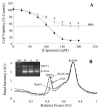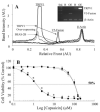Capsaicinoids cause inflammation and epithelial cell death through activation of vanilloid receptors
- PMID: 12721390
- PMCID: PMC2423488
- DOI: 10.1093/toxsci/kfg044
Capsaicinoids cause inflammation and epithelial cell death through activation of vanilloid receptors
Abstract
Capsaicinoids, found in less-than-lethal self-defense weapons, have been associated with respiratory failure and death in exposed animals and people. The studies described herein provide evidence for acute respiratory inflammation and damage to epithelial cells in experimental animals, and provide precise molecular mechanisms that mediate these effects using human bronchiolar and alveolar epithelial cells. Inhalation exposure of rats to pepper sprays (capsaicinoids) produced acute inflammation and damage to nasal, tracheal, bronchiolar, and alveolar cells in a dose-related manner. In vitro cytotoxicity assays demonstrated that cultured human lung cells (BEAS-2B and A549) were more susceptible to necrotic cell death than liver (HepG2) cells. Transcription of the human vanilloid receptor type-1, VR1 or TRPV1, was demonstrated by RT-PCR in all of these cells, and the relative transcript levels were correlated to cellular susceptibility. TRPV1 receptor activation was presumably responsible for cellular cytotoxicity, but prototypical functional antagonists of this receptor were cytotoxic themselves, and did not ameliorate capsaicinoid-induced damage. Conversely, the TRPV1 antagonist capsazepine, as well as calcium chelation by EGTA ablated cytokine (IL-6) production after capsaicin exposure. To address these seemingly contradictory results, recombinant human TRPV1 was cloned and overexpressed in BEAS-2B cells. These cells exhibited dramatically increased cellular susceptibility to capsaicinoids, measured using IL-6 production and cytotoxicity, and an apoptotic mechanism of cell death. Surprisingly, the cytotoxic effects of capsaicin in TRPV1 overexpressing cells were also not inhibited by TRPV1 antagonists or by treatments that modified extracellular calcium. Thus, capsaicin interacted with TRPV1 expressed by BEAS-2B and other airway epithelial cells to cause the calcium-dependent production of cytokines and, conversely, calcium-independent cell death. These results have demonstrated that capsaicinoids contained in pepper spray products produce airway inflammation and cause respiratory epithelial cell death. The mechanisms of these cellular responses to capsaicinoids appear to proceed via distinct cellular pathways, but both pathways are initiated by TRPV1.
Figures







Similar articles
-
Structure-activity relationship of capsaicin analogs and transient receptor potential vanilloid 1-mediated human lung epithelial cell toxicity.J Pharmacol Exp Ther. 2011 May;337(2):400-10. doi: 10.1124/jpet.110.178491. Epub 2011 Feb 22. J Pharmacol Exp Ther. 2011. PMID: 21343315 Free PMC article.
-
TRPV1 antagonists elevate cell surface populations of receptor protein and exacerbate TRPV1-mediated toxicities in human lung epithelial cells.Toxicol Sci. 2006 Jan;89(1):278-86. doi: 10.1093/toxsci/kfi292. Epub 2005 Aug 24. Toxicol Sci. 2006. PMID: 16120755 Free PMC article.
-
Calcium-dependent and independent mechanisms of capsaicin receptor (TRPV1)-mediated cytokine production and cell death in human bronchial epithelial cells.J Biochem Mol Toxicol. 2005;19(4):266-75. doi: 10.1002/jbt.20084. J Biochem Mol Toxicol. 2005. PMID: 16173059 Free PMC article.
-
Metabolism of capsaicinoids by P450 enzymes: a review of recent findings on reaction mechanisms, bio-activation, and detoxification processes.Drug Metab Rev. 2006;38(4):685-706. doi: 10.1080/03602530600959557. Drug Metab Rev. 2006. PMID: 17145696 Free PMC article. Review.
-
Final report on the safety assessment of capsicum annuum extract, capsicum annuum fruit extract, capsicum annuum resin, capsicum annuum fruit powder, capsicum frutescens fruit, capsicum frutescens fruit extract, capsicum frutescens resin, and capsaicin.Int J Toxicol. 2007;26 Suppl 1:3-106. doi: 10.1080/10915810601163939. Int J Toxicol. 2007. PMID: 17365137 Review.
Cited by
-
Biological Properties, Bioactive Constituents, and Pharmacokinetics of Some Capsicum spp. and Capsaicinoids.Int J Mol Sci. 2020 Jul 22;21(15):5179. doi: 10.3390/ijms21155179. Int J Mol Sci. 2020. PMID: 32707790 Free PMC article. Review.
-
Modulation of TRPV-1 by prostaglandin-E2 and bradykinin changes cough sensitivity and autonomic regulation of cardiac rhythm in healthy subjects.Sci Rep. 2020 Sep 16;10(1):15163. doi: 10.1038/s41598-020-72062-y. Sci Rep. 2020. PMID: 32938990 Free PMC article. Clinical Trial.
-
Extensive Exposure to Tear Gases in Ankara.Turk Thorac J. 2019 Jan 31;20(2):108-113. doi: 10.5152/TurkThoracJ.2018.18096. Print 2019 Apr. Turk Thorac J. 2019. PMID: 30958982 Free PMC article.
-
Capsaicin-induced Ca2+ signaling is enhanced via upregulated TRPV1 channels in pulmonary artery smooth muscle cells from patients with idiopathic PAH.Am J Physiol Lung Cell Mol Physiol. 2017 Mar 1;312(3):L309-L325. doi: 10.1152/ajplung.00357.2016. Epub 2016 Dec 15. Am J Physiol Lung Cell Mol Physiol. 2017. PMID: 27979859 Free PMC article.
-
Structure-activity relationship of capsaicin analogs and transient receptor potential vanilloid 1-mediated human lung epithelial cell toxicity.J Pharmacol Exp Ther. 2011 May;337(2):400-10. doi: 10.1124/jpet.110.178491. Epub 2011 Feb 22. J Pharmacol Exp Ther. 2011. PMID: 21343315 Free PMC article.
References
-
- Billmire DF, Vinocur C, Ginda M, Robinson NB, Panitch H, Friss H, Rubenstein D, Wiley JF. Pepper-spray-induced respiratory failure treated with extracorporeal membrane oxygenation. Pediatrics. 1996;98:961–963. - PubMed
-
- Carter JD, Ghio AJ, Samet JM, Devlin RB. Cytokine production by human airway epithelial cells after exposure to an air pollution particle is metal-dependent. Toxicol. Appl. Pharmacol. 1997;146:180–188. - PubMed
-
- Caterina MJ, Julius D. The vanilloid receptor: A molecular gateway to the pain pathway. Annu. Rev. Neurosci. 2001;24:487–517. - PubMed
-
- Caterina MJ, Rosen TA, Tominaga M, Brake AJ, Julius D. A capsaicin-receptor homologue with a high threshold for noxious heat. Nature. 1999;398:436–441. - PubMed
-
- Caterina MJ, Schumacher MA, Tominaga M, Rosen TA, Levine JD, Julius D. The capsaicin receptor: A heat-activated ion channel in the pain pathway. Nature. 1997;389:816–824. - PubMed
Publication types
MeSH terms
Substances
Grants and funding
LinkOut - more resources
Full Text Sources
Other Literature Sources

